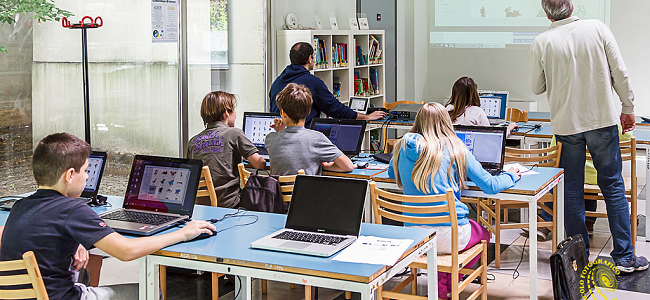At Crumpsall Lane Primary School, this was a project we embarked on throughout last year, and whilst our curriculum is still a work in progress, I hope that by sharing our thoughts, decisions and resources, we may assist schools negotiating similar changes.To begin with, we decided upon the five strands that would make up our computing curriculum, these being: Multimedia, Programming, E-Safety, Online and Data. We then developed skills progressions for each of these strands from Year 1 to Year 6.
In this article I’ll discuss the Programming, Multimedia and Online strand; however, our entire curriculum can be downloaded from www.primarycomputing.co.uk.
Programming
It is the introduction of the computer science elements of the new national curriculum that, from my experience, teachers are most fearful of, since this is the area of greatest change. However, we are keen to share here that such fears are easily allayed through experiential staff training, where teachers have the opportunity to have a go at programming and the technical terminology used in the new national curriculum is clarified in the context of doing.
Our Programming strand is entirely delivered using iPad apps in Key Stage 1. The apps we use include: Bee Bot; Daisy the Dino; Hopscotch and Move the Turtle. In Key Stage 2, pupils use Scratch, Kodu and Python to further develop their programming skills in a range of programming environments. In Year 5, pupils are also introduced to the Raspberry Pi, which is set up to run a version of Scratch that enables pupils to control a small motorised car via the output pins on the Pi. Demonstrating to pupils how software can be used to control physical hardware in the world around them really highlights the scope and significance of the programming skills they are developing.
To vary our approach to teaching computing, we also include a number of ‘computing without computers’ lessons, such as in Year 1 where pupils learn about algorithms by pairing up and taking turns guiding their robot partner (who can’t see out from under their robot mask!) around a maze in our hall.
To support teachers in designing and delivering lessons to match the skills objectives in our Programming progression, we developed a ‘guide to teaching programming’, which can also be downloaded. This guide introduces the apps and programs used within our curriculum via explanations and tutorials. It also provides suggestions for lessons and ‘coding challenges’, in which pupils have the opportunity to apply the skills and knowledge taught to solve problems.
Multimedia and Online
In this period of curriculum reform, we took the opportunity to review and evolve the Multimedia and Online strands of our ICT curriculum to ensure we were providing pupils with the opportunity to engage with contemporary technologies and online practices.
Within the Multimedia strand, pupils use a range of apps and programs to develop their skills in text, graphics, video editing, animation and digital audio manipulation. To show progression in their skills, pupils complete two units in each media type over Key Stages 1 and 2. To also aid progression we have utilised the trend for desktop-based applications to be available in cut-
down app form. For example, pupils in Year 2 use the iMovie app on the iPads, which offers limited functionality in comparison with iMovie on our Mac desktops, which pupils use in Year 6.
Within our Online strand, as well as learning about the effective use of websites, emails and search engines, pupils also learn about how search engines rank results and how websites are designed, created and hosted. In doing so we hope to not only develop our pupils’ skills as users of such technologies but also foster their interest in being the creators of technology. I hope this brief explanation of our work in developing our computing curriculum has provided some ideas and guidance for schools making similar changes. Please do get in touch with any comments or questions you may have, or to let us know how you have developed and adapted our materials for your school.
How do you currently feel about the upcoming curriculum changes? Let us know below.


















